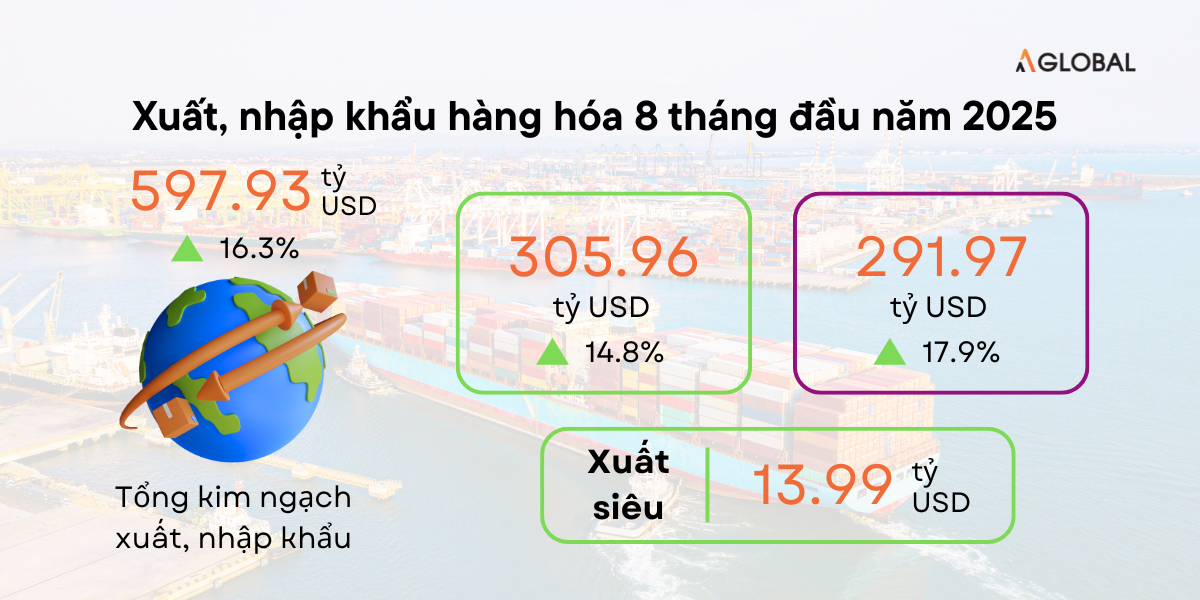
Top 10 key Vietnamese export products in 2025
In 2025, Vietnamese exports continue to affirm their position on the global trade map. Thanks to a diverse product structure, Vietnam is showing increasingly strong competitiveness. Along with that, the door to cross-border e-commerce opens up opportunities for businesses to elevate the “Made in Vietnam” brand on the international stage.
1. Overview of Vietnam’s Export Landscape in 2025
The year 2025 marks a strong restructuring phase for Vietnam’s exports, as many industries shift toward high-value production and sustainable development. To better understand this trend, let’s explore what Vietnamese export goods are and the current export situation this year.
1.1. What are Vietnamese Export Goods?
Vietnamese export goods (VNXK) are products manufactured by international brands through outsourcing in Vietnam and then exported to major markets such as Europe, America, Japan, or South Korea. These can include familiar items such as clothing, footwear, handbags, sportswear, or other light industrial products.
The key characteristic of Vietnamese export goods is high quality and strict standards, as the entire production process is directly controlled by the original brand. Materials, accessories, production lines, and techniques are provided by the company, and Vietnamese workers only carry out the trained procedures.
Therefore, Vietnamese export goods are considered authentic products (auth). Although they are not sold directly in Vietnam, they maintain the same quality as globally distributed products.

In addition, VNXK products are not freely allowed to be sold domestically. To be sold in Vietnam, companies must re-import them from foreign markets, leading to higher prices due to taxes and transportation costs. This also explains why many “Made in Vietnam” products are more expensive in the domestic market, despite being produced locally.
1.2. Current Situation of Vietnamese Exports in 2025
In 2025, Vietnam’s export activities continue to maintain positive growth momentum despite global economic fluctuations. In the first 8 months, export turnover reached more than USD 305.9 billion, up 14.8% year-on-year, demonstrating the strong resilience of Vietnamese goods in the global market.

Import and Export of Goods in the First 8 Months of 2025
The group of processed industrial goods remains the main driving force, accounting for nearly 89% of total export turnover, with many items exceeding USD 10 billion such as phones, components, computers, equipment, textiles, and footwear. Meanwhile, the agricultural sector also shows a strong recovery, with notable increases in seafood, coffee, fruits, and cashew nuts, driven by market expansion and improved processing quality.
The United States, China, the EU, and ASEAN continue to be key export markets, with the United States maintaining the top position with nearly USD 100 billion in export turnover.
Despite impressive results, Vietnamese exports still face challenges such as dependence on imported materials, strict technical barriers, and fluctuating logistics costs. However, with sustainable development strategies and business efforts, Vietnam’s export turnover in 2025 is expected to reach USD 470–480 billion, continuing to affirm its position in the global supply chain.
2. Top 10 Key Export Products of Vietnam
Below are the top 10 major export product groups that play a crucial role in the nation’s trade balance.
2.1. Phones and Components
Thanks to strong investment from tech giants such as Samsung, Apple, LG, and Nokia, Vietnam has emerged as a leading global hub for mobile device manufacturing and assembly. In June 2025, export turnover for phones and components reached approximately USD 4.5 billion, maintaining its position as Vietnam’s top export sector.
The industry is shifting toward the production of complex and high-tech components, marking Vietnam’s clear advancement in the global supply chain.
2.2. Computers, Electronic Products, and Components
Ranking second in export structure, this group achieved USD 9.27 billion in June 2025, up 1.3% from the previous month. It is the highest-value category, serving as the “backbone” of Vietnam’s digital economy. Beyond revenue generation, it also promotes technology transfer and the development of a high-skilled labor force.
2.3. Textiles and Garments
The textile and garment industry remains one of Vietnam’s traditional export pillars, with turnover of around USD 3.6 billion in June 2025, up nearly 10% month-on-month.
Key products such as ready-made clothing, fabrics, and accessories not only contribute major revenue but also create jobs for millions nationwide. The industry is now transforming toward green production and sustainability, meeting strict standards on origin, environment, and labor.
Read more: Does Vietnam’s Textile Industry Have Enough Capacity to Invest Abroad?
2.4. Footwear
The footwear sector recorded around USD 2.13 billion in monthly exports. With skilled labor and flexible production capacity, Vietnam partners with major global brands such as Nike, Adidas, and Puma. Companies are actively adopting green transformation practices, using recycled materials and eco-friendly technology to align with global sustainable consumption trends.
2.5. Wood and Wood Products
The wood industry reached USD 1.35 billion in June 2025. Major exports include furniture, plywood, and decorative items to the U.S., EU, and Japan. Businesses are focusing on FSC certification, intricate design, and sustainable production while investing in automation and advanced processing technology to improve productivity and value.
2.6. Seafood
Vietnamese seafood exports hit USD 906 million in June 2025, with shrimp, pangasius, and tuna as key products. The industry is applying modern aquaculture technology, ensuring food safety, traceability, and deep processing to increase value. However, climate change and technical barriers remain major challenges.
2.7. Fruits and Vegetables
Fruits and vegetables saw strong growth, reaching nearly USD 807 million in June—up over 30%. Major products such as durian, dragon fruit, and passion fruit have helped Vietnam expand into markets like China, South Korea, the U.S., and the EU. Businesses are focusing on processing, preservation, and standardizing procedures to shift toward high-quality exports.
2.8. Rice
Rice continues to serve as a strategic agricultural export, keeping Vietnam among the world’s top three exporters. Businesses are developing premium aromatic, glutinous, and white rice varieties combined with modern milling and preservation technology. As a result, Vietnamese rice is increasingly recognized for its quality and safety.
2.9. Transportation Vehicles and Spare Parts
This group reached USD 1.46 billion in June 2025, up 2.6%. Vietnam is becoming a manufacturing hub for components, motorcycles, and auto parts for the U.S., EU, Japan, and South Korea. The rise of VinFast and supporting industries enhances the mechanical sector, leveraging FTAs to expand market access.
2.10. Coffee
Vietnam remains the world’s second-largest coffee exporter, primarily of Robusta beans. In 2025, export value grew significantly thanks to product diversification, including instant, specialty, and organic coffee. Key markets include Germany, the U.S., and Italy. The sector is pushing for deep processing and sustainable development to boost the global reputation of Vietnamese coffee.
Read more: Coffee Market Q4/2025: Opportunities for Vietnamese Businesses
3. Major Export Markets for Vietnamese Goods
Vietnamese exports have reached over 200 countries, with the U.S., China, the EU, and ASEAN as key markets. Each region presents distinct characteristics and requirements, offering both opportunities and challenges for Vietnamese enterprises on their path to global recognition.

3.1. The United States
The U.S. remains Vietnam’s largest export market, reaching USD 112.8 billion in the first 9 months of 2025—up 27.7%. Key exports include electronics, textiles, footwear, and wood. Despite strict standards, Vietnamese businesses are effectively leveraging FTAs and the green production trend to expand market share.
3.2. China
Holding second place with USD 49.6 billion, up 11.3%, China is a crucial market for many Vietnamese sectors, particularly agriculture, seafood, and electronics. Geographic proximity facilitates trade, but companies must still adapt to China’s strict import control policies to maintain stable turnover.
3.3. European Union (EU)
The EU market contributed USD 41.7 billion in the first 9 months of 2025, up 9.3% year-on-year. It is a major destination for Vietnam’s textiles, footwear, wood, and agricultural products. Thanks to the EVFTA, Vietnamese goods benefit from tax advantages, though they must meet increasingly stringent environmental, labor, and traceability standards, driving a sustainable export shift.
3.4. ASEAN
With USD 28.5 billion, up 2.9%, ASEAN remains a key regional market. Major exports include petroleum, steel, electronics, and agricultural products. Although growth is moderate, this market provides a stable foundation for Vietnamese enterprises to expand networks and maintain competitiveness in the region.
4. E-commerce: A New Direction for Vietnamese Exports
In recent years, e-commerce has become a highly promising export channel for Vietnamese goods, enabling global consumer access beyond geographical limits. According to the Ministry of Industry and Trade, in 2023, Vietnam’s e-commerce market reached approximately USD 20.5 billion, ranking among the top 3 in Southeast Asia and one of the most dynamic online markets in the region.
Notably, cross-border exports via digital platforms have seen strong growth. On Amazon alone, in 2024, over 17 million Vietnamese products were sold, with transaction value up 50% and the number of sellers rising by nearly 40% compared to the previous year. These figures highlight the growing global appeal of Vietnamese products on international e-commerce platforms.
According to the Vietnam E-commerce Association (VECOM), B2C cross-border exports through digital platforms could reach USD 5.5 billion by 2027 if businesses effectively leverage technology and logistics. Platforms such as Amazon, Walmart, and Alibaba are becoming key “gateways” for Vietnamese goods to reach global consumers.
If businesses want to learn how to bring Vietnamese products to international e-commerce platforms, they can connect with AGlobal – a companion of hundreds of Vietnamese brands in their export journey through Amazon and global digital channels.
Read more: B2B E-commerce Trends 2025: Leading the Future of Business
Read more: Discover Effective E-commerce Platform Management Solutions
5. Conclusion
In the context of globalization, Vietnam’s exports are transforming from “outsourcing” to “brand building.” To maintain growth and enhance value, businesses need to innovate technology, invest sustainably, and leverage e-commerce effectively. With the right strategies and policy support, Vietnamese export goods can go further and assert their position in the global market.
AGlobal – The best cross-border e-commerce solution for businesses.
Register for a free 1-on-1 consultation tailored to your business sector Here!
